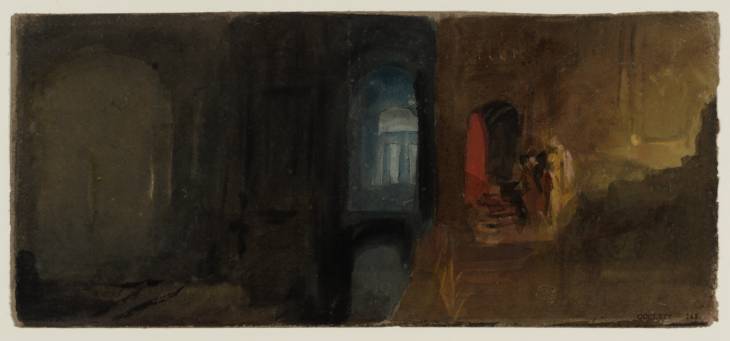Joseph Mallord William Turner Two Figures in a Dark Arcade, Perhaps in Venice ?1840
Joseph Mallord William Turner,
Two Figures in a Dark Arcade, Perhaps in Venice
?1840
Joseph Mallord William Turner 1775–1851
Two Figures in a Dark Arcade, Perhaps in Venice ?1840
D36089
Turner Bequest CCCLXIV 243
Turner Bequest CCCLXIV 243
Gouache and watercolour on grey-brown wove paper, 101 x 227 mm
Blind-stamped with Turner Bequest monogram below right of centre
Stamped in black ‘CCCLXIV – 243’ bottom right
Blind-stamped with Turner Bequest monogram below right of centre
Stamped in black ‘CCCLXIV – 243’ bottom right
Accepted by the nation as part of the Turner Bequest 1856
Exhibition history
1975
Turner in the British Museum: Drawings and Watercolours, Department of Prints and Drawings, British Museum, London, May 1975–February 1976 (189, as ‘Figures on a flight of steps in an architectural setting’, ?c.1832, reproduced).
References
1909
A.J. Finberg, A Complete Inventory of the Drawings of the Turner Bequest, London 1909, vol.II, p.1192, CCCLXIV 243, as ‘The lovers’, after about 1830.
1832
Andrew Wilton, Turner in the British Museum: Drawings and Watercolours, exhibition catalogue, Department of Prints and Drawings, British Museum, London 1975, pp.119–20 no.189, as ‘Figures on a flight of steps in an architectural setting’, ?c.1832, reproduced, p.134, under no.216.
1990
Andrew Wilton, ‘Picture Note: Study for the Sack of a Great House? (“Interior at Petworth”)’, Turner Studies, vol.10, no.2, Winter 1990, p.59 note 5.
1997
Eric Shanes, Turner’s Watercolour Explorations 1810–1842, exhibition catalogue, Tate Gallery, London 1997, p.103, under ‘Venice?’.
This shadowy, elusive subject, its small figures as it were spotlit in bright touches of within the looming architectural setting, is somewhat reminiscent of the nightmarish prison scenes of Giovanni Battista Piranesi (1720–1778), whose work Turner knew and occasionally echoed (see Tate D17090, D17099; Turner Bequest CXCV 120, 128). Not mentioned in the standard surveys of Turner’s Venice work,1 it is included here as perhaps representing a claustrophobic fantasy on the alleys, archways and side canals evoked in colour studies associated with Turner’s 1840 visit such as such as Tate D32239 and D32257 (CCCXVIII 20, CCCXIX 9). As with some of the other figure studies in the present grouping, it may have a literary source.
Andrew Wilton first suggested a possible Venetian connection on account of ‘some technical characteristics in common’ with more readily identifiable 1840 subjects on grey and brown papers, albeit the handling here is ‘much tighter’.2 He also compared the ‘theatrical quality of the composition and the lighting’ of a night view of the Piazzetta (Tate D32220; Turner Bequest CCCXVIII 1).3 Wilton also made wider comparisons with several earlier pencil drawings of complex but provisional architectural subjects in the Ports of England sketchbook of about 1822–3 (Tate D17775; CCII 30a) and the Mouth of the Thames book of about 1832 (Tate D27227–D27228; CCLXXVIII 1a, 2).4 There seems to be no direct connection and any resemblance is likely generic. He has also noted the present sheet in terms of the ‘similar architectural features’5 in the unresolved painting currently known as Interior of a Great House: The Drawing Room, East Cowes Castle and dated to about 1830 (Tate N01988),6 which he discussed in relation to other East Cowes subjects (see the ‘Isle of Wight 1827’ section of the present catalogue).
Of more immediate relevance is Wilton’s suggestion in that context that this work ‘may have been executed at the same time’ as Tate D36259 (Turner Bequest CCCLXIV 392),7 which he described briefly as ‘a dark interior, apparently a bedroom’.8 Noting Wilton’s initial Venetian suggestion in the present case, Eric Shanes categorised both as ‘Venice?’ scenes without further comment.9 D36259 is also included in this subsection as a likely Venice subject, reflecting subsequent discussion, and also the apparently direct physical relationship between the two sheets, as noted below.
See A.J. Finberg, In Venice with Turner, London 1930, Lindsay Stainton, Turner’s Venice, London 1985 and Ian Warrell, David Laven, Jan Morris and others, Turner and Venice, exhibition catalogue, Tate Britain, London 2003.
Technical notes:
Visual examination indicates that the bottom edge of this sheet and the top edge of Tate D36259 (Turner Bequest CCCLXIV 392) appear to match, as do the narrow unpainted margin on the left the rough edge at the right of each, suggesting that they were originally joined. An irregular strip of unrelated dark colour at the bottom right seems continuous with the shadowy wall at the top right of D36259, implying that the two were at least partly worked on together before being neatly torn into two along a fold or straight edge, which would not be unusual in Turner’s practice; see for instance the technical notes for Tate D32252 (Turner Bequest CCCXIX 4) in the present grouping.
As neither of the two sheets was included in Ian Warrell’s technical notes on the supports used for Turner’s Venice subjects, including the various mid-toned grey and brown Italian papers which appear similar,1 the possibility that they were once parts of a single sheet of that sort awaits confirmation.
Verso:
Blank; stamped in black with Turner Bequest monogram over ‘[...]’ bottom right.
Matthew Imms
September 2018
How to cite
Matthew Imms, ‘Two Figures in a Dark Arcade, Perhaps in Venice ?1840 by Joseph Mallord William Turner’, catalogue entry, September 2018, in David Blayney Brown (ed.), J.M.W. Turner: Sketchbooks, Drawings and Watercolours, Tate Research Publication, December 2019, https://www

